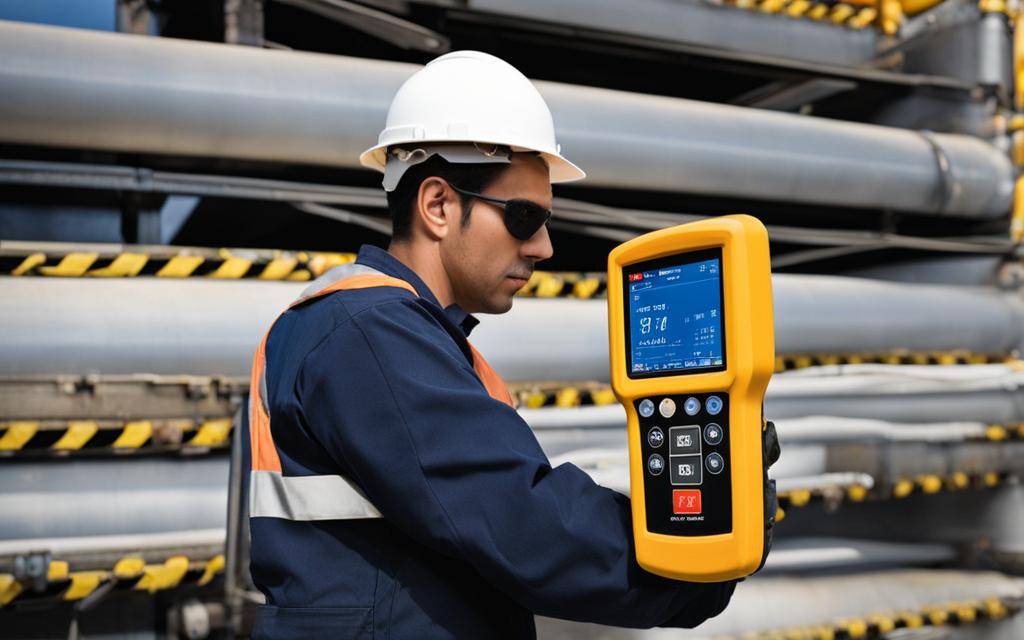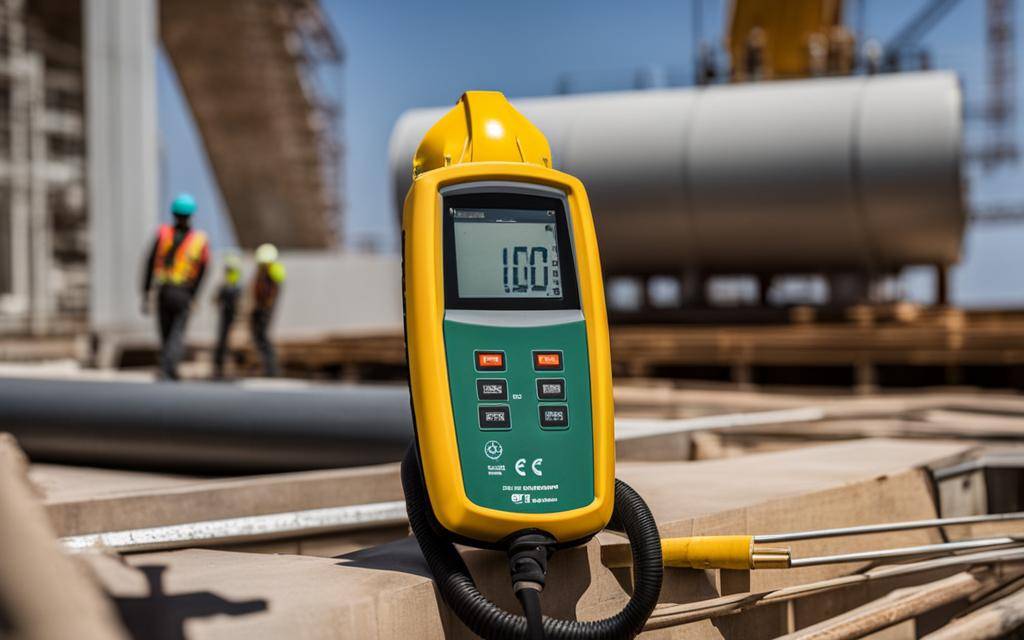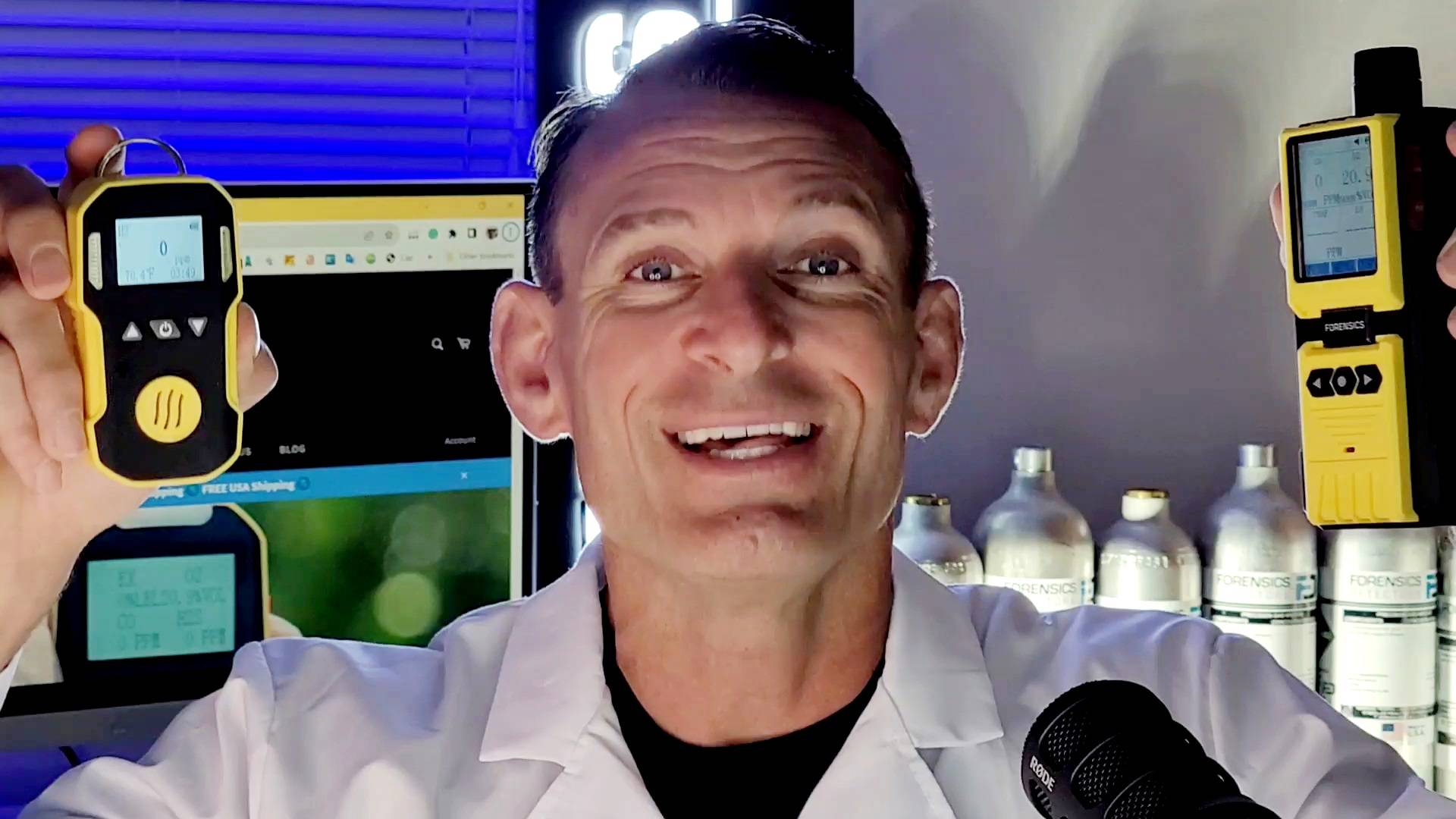Welcome to our guide on how to effectively use a 4 gas monitor for accurate readings of gas concentrations and ensure maximum safety in various settings. Whether you’re working in industries such as pharmaceuticals, indoor agriculture, fire suppression testing, sanitation, or industrial processes, a 4 gas monitor or gas detector is a versatile tool that can detect multiple gas concentrations simultaneously.
With its ability to measure oxygen (O2), carbon monoxide (CO), hydrogen sulfide (H2S), and combustible gases (LEL), the 4 gas monitor provides real-time analysis of the gas levels. Oxygen levels are displayed as a percentage, while CO and H2S levels are displayed in parts per million (PPM). Combustible gas measurements are displayed as a percentage of the lower explosive limit (%LEL).
To ensure accurate readings and reliable performance, it is crucial to follow the manufacturer’s instructions for calibration, bump testing, and zeroing the instrument. Regular maintenance practices, such as calibration and testing, are also essential. By adhering to these practices, you can rely on your 4 gas monitor to provide accurate and timely information about gas concentrations, enabling you to take appropriate actions to maintain a safe working environment.
What Is a Multi Gas Detector?
A multi gas detector, also known as a 4 gas monitor or 4 gas meter, is a handheld device designed to detect multiple gas concentrations simultaneously. It is commonly used in industries such as pharmaceutical, indoor agriculture, fire suppression testing, sanitation, and industrial processes.
Multi gas detectors are essential personal gas devices that ensure the safety of workers in enclosed spaces by monitoring gas concentrations in real-time. These devices utilize sensors to detect various gases, including carbon monoxide (CO), hydrogen sulfide (H2S), oxygen (O2), and combustible gases. They provide accurate readings and instant analysis of gas levels.
Not only do multi gas detectors detect hazardous gases, but some models also offer data logging capabilities. This allows for the recording and monitoring of gas concentrations over time, enabling users to analyze trends and make informed decisions to maintain safety protocols and prevent potential risks.
| Gases Detected | Applications |
|---|---|
| Carbon monoxide (CO) | Industrial processes, fire suppression testing |
| Hydrogen sulfide (H2S) | Pharmaceutical, indoor agriculture |
| Oxygen (O2) | Sanitation, confined spaces |
| Combustible gases | Oil and gas, chemical manufacturing |
With their portable and compact design, multi gas detectors provide a crucial line of defense against gas-related hazards. By continuously monitoring gas concentrations, these devices help ensure a safe working environment and protect the well-being of employees.
How Does a 4 Gas Monitor Work?
A 4 gas monitor functions as a hand-held computer that utilizes gas sensors to collect and analyze gas sensor data. The monitor’s primary purpose is to detect gas levels and trigger an alarm if any of the levels exceed safe limits.
To achieve this, the monitor is equipped with sensors designed to detect specific gases of interest, such as oxygen (O2), carbon monoxide (CO), hydrogen sulfide (H2S), and combustible gases. These sensors continuously measure the concentration of these gases in the surrounding environment.
The monitor’s hand-held computer, powered by printed computer boards filled with integrated circuit (IC) chips, processes and displays the real-time gas sensor data. This data is presented on a screen or can be saved in a log file for further analysis.
One of the key features of a 4 gas monitor is its portable design, making it convenient to use in various field applications. Its compact size and lightweight construction allow users to carry it easily, wherever they may need to monitor gas levels.
Additionally, 4 gas monitors are designed with long battery life, ensuring extended use without the need for frequent recharging.
To maintain accuracy and reliability, it is crucial to calibrate the monitor regularly. Calibration involves adjusting the monitor’s settings to ensure its measurements align with known gas concentrations. This process ensures accurate performance and helps prevent false alarms or missed detections.
Overall, a 4 gas monitor’s portable design, gas sensors, hand-held computer, and alarm functionality make it an indispensable tool for monitoring gas levels in various industries to ensure the safety of workers and the surrounding environment.

Pros and Cons of Using a 4 Gas Monitor
Using a 4 gas monitor offers several benefits for maximum safety in hazardous environments. These portable devices are designed to detect a wide range of hazardous gases in real time, providing crucial information to protect workers and prevent potential risks.
One of the key advantages of a 4 gas monitor is its portability. These monitors are compact and lightweight, allowing them to be easily carried from one location to another. Whether workers need to move around a large site or perform remote monitoring, a portable 4 gas monitor ensures constant vigilance and safety.
Another valuable feature is the data logging capabilities of some 4 gas monitors. This allows for continuous monitoring of gas concentrations over time, ensuring thorough data collection for analysis and compliance reporting. With data logging, safety managers can track trends, identify potential hazards, and make informed decisions to enhance workplace safety.
However, it’s essential to consider the drawbacks of using a 4 gas monitor. Routine calibration and testing are necessary for accurate performance. Calibrating the monitor at regular intervals ensures that it provides precise readings and maintains its reliability. Gas sensors have a limited lifespan, and they may require replacement over time, which adds to the maintenance costs.
Furthermore, while 4 gas monitors can detect multiple hazardous gases, they may not have the capability to monitor every hazardous gas in one device. The specific gases detected depend on the sensors installed in the monitor. Therefore, it’s important to identify the relevant gases for your specific application and ensure the monitor is equipped accordingly.
Pros and Cons of Using a 4 Gas Monitor:
| Pros | Cons |
|---|---|
| Ensures maximum safety by detecting hazardous gases in real time | Routine calibration and testing required for accurate performance |
| Portable design allows for quick monitoring in various locations | Lifespan of gas sensors may vary and require replacement |
| Data logging capabilities enable continuous monitoring and trend analysis | May not be able to monitor every hazardous gas in one device |
In conclusion, using a 4 gas monitor provides maximum safety by detecting hazardous gases in real time. These portable devices offer the convenience of quick monitoring and some models provide data logging capabilities for comprehensive analysis. However, routine calibration, maintenance, and the limitations of gas sensors should be considered when using a 4 gas monitor.

What Does a 4 Gas Monitor Detect?
A 4 gas monitor is a powerful tool that can accurately detect various gases to ensure safety in different environments. It is capable of detecting the following gases:
- Oxygen (O2)
- Carbon monoxide (CO)
- Carbon dioxide (CO2)
- Ammonia (NH3)
- Hydrogen sulfide (H2S)
- Methane (CH4)
- Combustible gases like propane and methane
Some models of 4 gas monitors may even detect additional gases such as industrial solvents, alcohol, and natural gas. The specific gases that a 4 gas monitor can detect depend on the sensors installed in the device. To ensure that the monitor is capable of detecting the gases relevant to your application, it is essential to check the manufacturer’s specifications.
Why Use a Gas Detector?
Using a gas detector is critically important to ensure safety in environments where hazardous gases may be present. Gas detectors serve as a crucial line of defense against potential risks associated with gas exposure, including low oxygen atmospheres, carbon dioxide (CO2) buildup, the presence of combustible gases, and other potentially life-threatening environments.
Gas detectors incorporate advanced gas sensors that detect and measure the concentrations of different gases in the atmosphere. These sensors continuously monitor the air quality and provide real-time data, alerting users to any hazardous gas concentrations. This proactive approach allows individuals to take immediate action and mitigate potential dangers before they escalate.
Gas detectors find widespread application in various industries, including oil and gas, chemical manufacturing, pharmaceuticals, and fire suppression. In these sectors, where exposure to hazardous gases is a significant concern, gas detectors play a critical role in ensuring the safety and well-being of workers.
Risks Addressed by Gas Detectors
Gas detectors help mitigate a range of risks associated with hazardous gases, including:
- Low Oxygen Atmospheres: In confined spaces or areas with poor ventilation, gas detectors help monitor the oxygen levels, preventing asphyxiation and promoting a safe working environment.
- Carbon Dioxide (CO2) Exposure: Elevated levels of CO2 can lead to dizziness, headaches, and even unconsciousness. Gas detectors provide early warnings, allowing individuals to evacuate or ventilate the area.
- LEL or Combustible Gases: Gas detectors are vital for detecting the presence of combustible gases, such as methane and propane, which can pose significant fire and explosion hazards.
- Other Hazardous Gases: Gas detectors can also detect gases like hydrogen sulfide (H2S), ammonia (NH3), and other industrial solvents, providing critical information to prevent harmful exposure.
By monitoring gas concentrations, gas detectors enable workers to make informed decisions and take appropriate actions to ensure their safety. Early detection of hazardous gases is key to preventing accidents, protecting lives, and maintaining a secure work environment.
| Gas | Description |
|---|---|
| Oxygen (O2) | Measures oxygen levels to prevent asphyxiation and ensure adequate oxygen supply for breathing. |
| Carbon Monoxide (CO) | Detects toxic levels of CO, which can lead to carbon monoxide poisoning and impair cognitive function. |
| Hydrogen Sulfide (H2S) | Identifies dangerous concentrations of H2S, a hazardous gas with a “rotten egg” odor, known for its toxic and flammable properties. |
| Combustible Gases (LEL) | Detects the presence of combustible gases, such as methane and propane, to prevent fire and explosion risks. |
| Ammonia (NH3) | Monitors NH3 levels, commonly found in agriculture and industrial applications, to prevent respiratory and eye irritation. |
| Methane (CH4) | Detects potentially explosive levels of methane, commonly found in natural gas leaks, ensuring early intervention. |
Gas detectors are vital tools for protecting lives and promoting safe work environments. By promptly identifying and alerting individuals to hazardous gas concentrations, gas detectors enable informed decision-making, preventing accidents and potential harm. It is crucial to invest in reliable gas detectors and follow recommended maintenance practices to ensure accurate and reliable performance.
How to Calibrate a Multi Gas Detector
Calibrating a multi gas detector is a necessary process to ensure accurate readings. Calibration involves adjusting the device to provide precise measurements for the detected gases. The specific calibration procedure may vary depending on the make and model of the detector, so it’s crucial to consult the user manual for step-by-step instructions.
To calibrate the multi gas detector, you will need calibration gas that is specific to the gases being detected. This calibration gas is used to test the accuracy of the sensors and fine-tune the readings. Ensure that you have the correct calibration gas before starting the process.
Start by turning on the detector and allowing it to warm up. This ensures that the device is operating under optimal conditions for calibration. Wait for the warm-up period mentioned in the user manual before proceeding.
Once the detector is ready, follow the precise instructions in the user manual for calibrating each gas sensor. The procedure may involve adjusting the settings, initiating a calibration sequence, and exposing the sensors to the calibration gas. Follow these instructions diligently to achieve accurate calibration.
During the calibration process, the detector will provide readings based on the calibration gas. Compare these readings to the known concentrations of the calibration gas to ensure accuracy. If the readings match the expected concentrations, the calibration is successful.
It’s important to note that calibration should be performed regularly as recommended by the manufacturer. This ensures that the detector continues to provide accurate readings over time.
Once the calibration is complete and accurate readings are achieved, you can confidently use the multi gas detector for detecting and monitoring hazardous gases in various environments. Regular calibration and adherence to the user manual’s instructions are essential for reliable performance and ensuring the safety of workers.
Conclusion
A 4 gas monitor, also known as a gas detector, is a vital tool for ensuring safety in environments where hazardous gases may be present. These devices play a crucial role in protecting workers by detecting gas concentrations in real time, providing them with the essential information they need to take appropriate action and prevent potential risks.
To use a 4 gas monitor effectively, it is imperative to follow the manufacturer’s instructions for calibration, bump testing, and maintenance. Regular calibration and testing are necessary to ensure accurate readings and reliable performance. Proper care and usage of a 4 gas monitor can contribute to a safer work environment for all.
With its ability to detect multiple gas concentrations simultaneously, a 4 gas monitor provides workers with valuable insights into potential hazards. By adhering to calibration procedures and maintenance practices, users can trust that the readings provided by their gas detector are accurate and dependable.
When it comes to safety, there are no shortcuts. Investing in a high-quality 4 gas monitor and committing to regular calibration and testing is essential for protecting workers and maintaining a safe workplace. By prioritizing safety and utilizing accurate gas detection technology, businesses can ensure the well-being of their employees and minimize potential risks.

